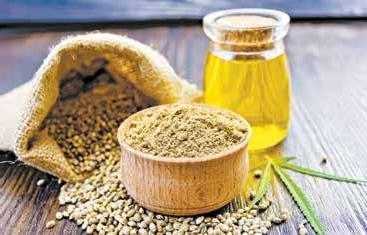
8 minute read
GETTING PREGNANT
Lifestyle Strategies to Boost Fertility
by Ronica O’Hara
When Rebecca Fett was told at age 26 that she had “incredibly low odds” of being able to conceive with her own eggs, she used her biochemistry and genetics training to plunge into research on egg quality and fertility. By taking targeted supplements, upgrading her diet and detoxing her house of harmful chemicals, the result was not only two healthy baby boys, but a book entitled It Starts with the Egg: How the Science of Egg Quality Can Help You Get Pregnant Naturally, Prevent Miscarriage, and Improve Your Odds in IV.
It sells at the fast clip of about 600 copies a week, showing that even amidst the traumas of the pandemic, couples fervently want to bear children. Some doula groups on the East Coast report a 30 percent rise in early 2021 births, and sperm banks are running so low that sperm from a handsome new donor posted online can be bought out within hours, reports The New York Times. “There is nothing more hopeful than the creation of a new life,” says Randine Lewis, who used acupuncture and Chinese herbs to enable a hard-won pregnancy and then wrote The Infertility Cure: The Ancient Chinese Wellness Program for Getting Pregnant and Having Healthy Babies.
Egg Matters. A healthy pregnancy depends on a healthy egg. Chromosomal abnormalities severely hamper fertilization and account for more than half of first-trimester miscarriages. Yet, contrary to common belief, egg quality is not determined solely by a woman’s age: it can be highly influenced by her lifestyle choices and nutrients in the three-month window before an egg is fertilized, Fett advises. Based on the latest research, she offers the following recommendations for women trying to conceive naturally or through such means as in vitro fertilization (IVF): Detox the diet. To manage critically important blood sugar and insulin levels, eat low-glycemic, nutrient-rich foods and avoid sugar, caffeine and alcohol. An organic, largely plant- and fish-based Mediterranean diet boosts fertility. Dutch researchers found that women following this diet before an IVF cycle had a 40 percent higher chance of becoming pregnant. Supplement correctly. Take a prenatal vitamin, vitamins C and E, ubiquinol and melatonin. For women with diagnosed low ovarian reserve, consider carefully dosed DHEA. Detox the house. The Bisphenol A (BPA) in many household items and the phthalates in most scented products are endocrine disrupters that increase the risk of infertility and miscarriages, numerous studies show. Exchange plastic storage containers and water bottles for glass or stainless steel ones. Steer clear of fast food and processed food. Buy milk, oil, drinks and condiments in glass bottles rather than plastic ones. In the bathroom, toss hairspray, perfume and nail polish, and be wary of scented skin care products, air fresheners and detergents. Use non-toxic cleaning products.
An Eastern Perspective.
Taking a different tack, “Traditional Chinese Medicine (TCM) does not focus on forcing maximum egg production,” says Lewis. “We improve the quality and receptivity of the entire body, mind and spirit, and the reproductive physiology responds.”
TCM involves identifying imbalances in the body that are creating obstacles to pregnancy and then using acupuncture, herbs and diet to restore full health. Diagnosis is typically done by an acupuncturist or Chinese medicine doctor. (To find one locally, Lewis suggests asking pointedly, “How many cases of infertility have you been successful in resolving?”)
According to Lewis, self-diagnosis can also work. For example, sore breasts and irritability during ovulation can signify liver qi stagnation, and can be relieved by massaging certain acupressure points, taking black cohosh and meditating or doing yoga. General TCM strategies include: Acupuncture:Regular treatments “can stimulate the body’s hormonal system to do what it is supposed to: secrete the right hormones at the right time in a woman’s cycle,” says Lewis. Self-administered acupressure also works. Diet: Choose organic foods and hormone-free meats, and eat veggies cooked rather than raw. Nix caffeine, nicotine and alcohol. Supplements: Besides a high-potency, multivitamin-mineral complex, such nutrients as bee pollen, blue-green algae, wheatgrass, vitamin B6, CoQ10 and folic acid are often useful. Herbs: Specific herbal concoctions and powders can target imbalances and deficiencies at key points in the menstrual cycle. Stress-busters: Qigong breathing lowers stress, and nightly warm foot soaks increase blood flow to the pelvic organs.
“As we live more harmoniously, our fertility improves,” says Lewis. “It is vastly wise and responds to how we live, think, act and relate.”
Natural health writer Ronica O’Hara can be contacted at OHaraRonica@gmail.com.
Hemp-Derived Cannabidiol
A Primer on the Latest Research
by Sandra Yeyati

Ever since the Farm Bill of 2018 legalized the commercial production of hemp, U.S. sales of cannabidiol (CBD) have exploded onto the scene with hundreds, perhaps thousands, of vendors popping up around the country. CBD, a cannabinoid, is abundant in the hemp flower. “By law, hemp is defined as a variety of cannabis plant that has less than 0.3 percent THC, the psychoactive cannabinoid that induces a high,” says Shannon Livingston, a cannabis consultant for Florida Gulf Coast University, in Fort Myers.
Proven Benefits of CBD:“The enthusiasm for CBD is soaring above the actual scientific evidence,” says Peter Grinspoon, M.D., a leading medical cannabis expert and primary care physician at Massachusetts General Hospital. “What’s known is that it helps with childhood epilepsy, and the U.S. Food and Drug Administration has approved a CBD drug for that. It is believed, and there’s good animal data and some human data to suggest, that CBD helps with chronic pain, insomnia and anxiety.”
Anxiety Under Study: A clinical trial examining a high-CBD, lowTHC (the psychoactive component) sublingual custom formulation for patients with moderate to severe anxiety is being conducted by Staci Gruber, Ph.D., director of Marijuana Investigations for Neuroscientific Discovery at McLean Hospital, in Belmont, Massachusetts, and associate professor of psychiatry at Harvard Medical School. “In the open label phase of this study, we’ve seen a rather dramatic and precipitous drop in symptoms of anxiety and depression after four weeks of treatment. We’ll see if this holds in the double-blind phase, which is underway now,” she explains. Entourage Effect:Gruber notes that this customized formulation is a full-spectrum, whole-plant formula, saying, “You often seem to get a bigger bang for the buck using a full-spectrum or broad-spectrum (whole plant minus THC) product, rather than just a single extracted compound.” The process she’s describing is called the entourage effect—an assumption that all elements of the cannabis plant, working together, are most effective. “I believe there’s a significant role for terpenoids, flavonoids and other cannabinoid constituents of the plant, in addition to the big two (THC and CBD), and I have a grant to look at that very question,” she says.
How to Start CBD:Experts agree that the best approach is to start low and go slow. “With experimentation, the patient will know what works for them,” Grinspoon says. “When CBD doesn’t work with my patients, the next step is to add a little bit of medical cannabis; it often takes a very little dose to help them with their sleep or their chronic pain.” Medical marijuana has been legalized in 36 states and the District of Columbia.
Route of Administration:“When you smoke or vape, it’s an almost immediate onset, which is helpful for breakthrough pain, nausea and anything you want to treat immediately, but the effect is very short-lived,” Livingston explains. “For chronic pain, you might take a capsule or the patch that will last six to eight hours. If you want to fall asleep, a sublingual will work. For a skin condition, you might rub an oil on your skin. It’s really about the time of onset, how long you need it to last and what you’re treating.”
Ensuring Quality Control:“Choose CBD providers that are certified for good manufacturing practices; conduct batch-specific, third-party testing on all of their products; and provide certificates of analysis directly from those labs. These tests can detect the presence of heavy metals, bacterial or microbial life, mycotoxins and pesticides, and also provide cannabinoid potency and terpene profiles,” says Grace Kaucic, senior communications and content manager at Bluebird Botanicals, a CBD company in Louisville, Colorado.
Our Built-In Cannabinoids:In the mid-1990s, researchers discovered the endocannabinoid system of receptors and neurotransmitters throughout the body, which uses cannabinoids that our own bodies produce. “This system is believed to control homeostasis, the body’s ability to regulate itself and maintain normal functioning,” Grinspoon says, adding that he believes this system will become central to medicine over the next few years as more research is conducted.
Research is Ongoing: “It’s an incredibly exciting time for cannabis science,” Gruber says. “There’s every reason to be optimistic about the potential of harnessing and exploiting the benefits of cannabis and cannabinoids in ways that may still surprise us, but to be cautiously optimistic. It is not a panacea. It will never be one-size-fits-all.”
Sandra Yeyati, J.D., is a professional writer. Reach her at SandraYeyati@gmail.com.
Green Living department is sponsored by DE Filters LLC. See ad opposite page.
Why Would You Let Your Family Live in an Unsafe Home?
Why You Should Start Caring About Dirty Electricity Right Now!
Dirty Electricity (EMC; Electro Magnetic Conducted) emissions creates poor power quality, and has led to early home appliance failures, industrial equipment control failures, GFI outlet failures, pulsating and flickering lights. Besides the likely cost of thousands in appliance damage there are also serious detrimental health effects such as:


n Deep sunburn type feeling n Skin Sores n Muscle Soreness n Hypersensitivity, burning pain or nerve numbness for an extended period n High Frequency electrical currents exposure can lead to long lasting post stimulus reduction of a nerve’s conductibility, which might relate to potential nerve injuries. i.e dropping foot, difficulty walking, finger cramping, neuropathy, eyelid twitching, tinnitus, and heart palpitations.




